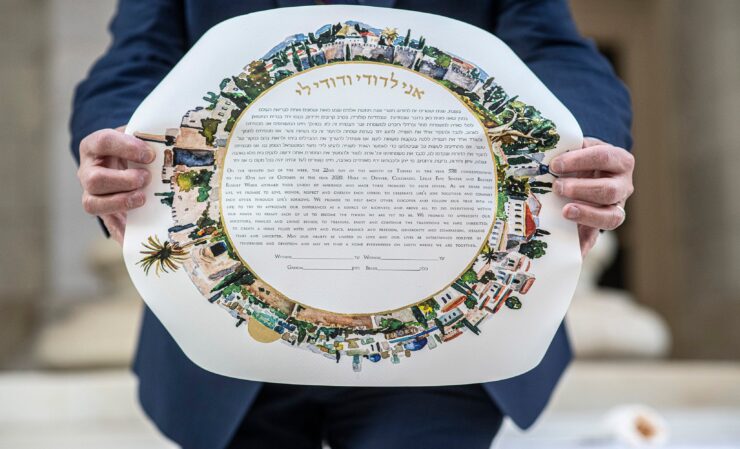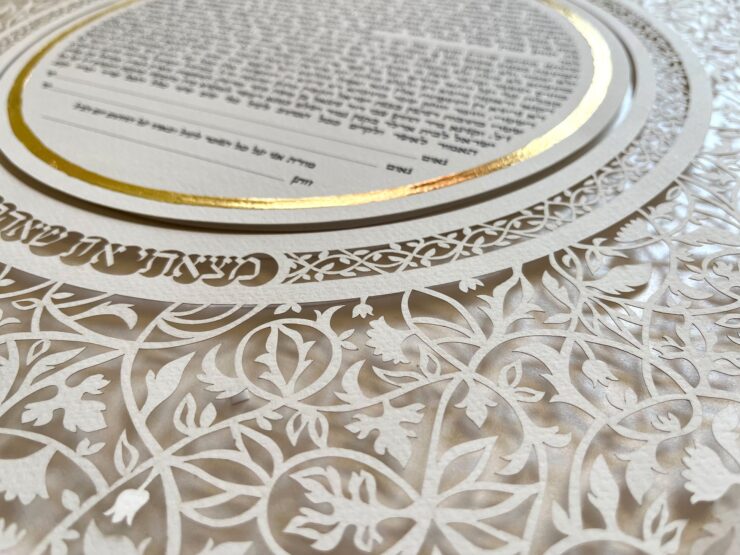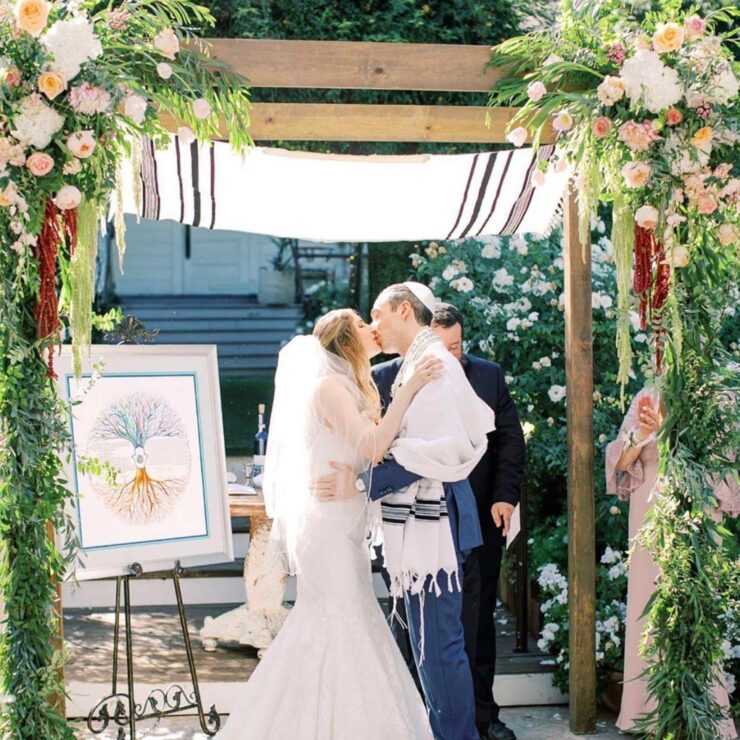Welcome to the enchanting world of Jewish wedding ceremonies, where tradition, symbolism, and profound meaning intertwine to create a truly magical experience. In this comprehensive guide, we will journey through the various rituals that make a Jewish wedding unique and unforgettable. From the signing of the ketubah to the joyous breaking of the glass, each step is significant, and we’ll uncover the deep-rooted traditions that make these ceremonies so special.
The Ketubah: A Pivotal Moment

At the heart of every Jewish wedding lies the signing of the ketubah, a pivotal moment that symbolizes commitment, love, and responsibility. The ketubah, a beautifully crafted marriage contract, outlines the rights and responsibilities of the couple. One fascinating trend in modern Jewish weddings is the choice of papercut ketubahs, adding an extra layer of artistry and personalization to this sacred tradition. Couples are increasingly drawn to these intricate designs, turning the signing of the ketubah into a visually stunning and emotionally charged experience.
Papercut Ketubahs: Elevating Tradition
Papercut ketubahs, with their delicate and detailed designs, have become a popular choice for couples seeking a unique and artistic representation of their commitment. The act of signing a papercut ketubah becomes a sensory-rich experience, as the couple witnesses the fusion of art and tradition. The careful selection of symbols and motifs on the ketubah can add layers of personal meaning, turning the signing ceremony into a reflection of the couple’s journey and shared aspirations.
As couples seek personalized expressions of love, many now opt for customized papercut ketubahs online by visiting here . This modern approach allows them to infuse unique elements into their ketubah, making it not just a legal document but a genuine reflection of their shared journey.
The Bedeken: Unveiling the Mystery
Before the wedding ceremony itself, the bride and groom participate in the bedeken, a touching and emotional tradition. The groom, accompanied by family and friends, veils his bride, a symbolic gesture dating back to the story of Jacob, Leah, and Rachel in the Bible. The act of veiling carries profound significance, representing the groom’s commitment to love and cherish his bride for who she is on the inside, beyond superficial appearances.
Unveiling the Papercut Ketubah: A Symbolic Revelation

As the groom unveils his bride during the bedeken, the papercut ketubah serves as a symbolic revelation of the couple’s shared journey. The intricacies of the papercut design, previously hidden, now come to light, mirroring the unfolding layers of their relationship. The unveiling becomes a moment of connection and anticipation, creating a bridge between the past and the future as the couple prepares to embark on their married life together.
Ketubah Designs
Ketubah designs offer couples an exciting canvas on which to infuse their individual stories of love into the fabric of tradition. The options range from gold accents that give the parchment a luxurious feel to the classic appeal of handwritten calligraphy. The possibilities are just as diverse as the couples. Whether they are elegantly simple or richly detailed, beautiful flowers infuse the sacred pact with a little bit of the beauty of nature. Couples looking to add a personal touch can select a drawing of a meaningful place that represents their journey or love tale. The ketubah is transformed into a live canvas with watercolors, which add a whimsical and artistic touch with their fluidity and dreamy nature. Every decision made in terms of design becomes a brushstroke in the story of love that couples can use to express their individuality and common experiences.
The Chuppah: Symbol of Home and Unity
The chuppah, a canopy held aloft by four poles, serves as the central element of the Jewish wedding ceremony. Symbolizing the home the couple will build together, the chuppah represents a sacred space for the exchange of vows and the beginning of their shared life. The open sides of the chuppah remind us of the couple’s openness to friends, family, and the broader community.
The Ketubah Under the Chuppah: A Covenant in the Canopy

The ketubah holds a place of honor as the couple stands beneath the chuppah. The papercut ketubah beneath the canopy adds an extra layer of symbolism, with the intricacies of the design casting intricate patterns of light and shadow. The papercut ketubah becomes a visual representation of the couple’s commitment, providing a backdrop to the sacred vows exchanged beneath the chuppah.
Witnesses in Ketubah Signing
In Jewish weddings, the ketubah signing is a vital moment requiring two adult Jewish witnesses. Their signatures, along with those of the bride, groom, and officiant, validate the document and the couple’s pledge. This practice highlights the communal nature of Jewish marriages, often involving friends or family as witnesses to represent broader community support.
Jewish Wedding Music
Music is a cornerstone of Jewish weddings, elevating the ceremony’s emotional tone. Classic songs like “Erev Shel Shoshanim” and “Dodi Li” add joy and spirituality. Live bands or klezmer groups often play celebratory melodies, while the hora dance unites guests in lively, communal circles, reflecting the event’s jubilant spirit.
Breaking the Glass
A defining moment in Jewish weddings is the breaking of the glass, rich in symbolism. It represents the fragility of relationships, the enduring commitment of marriage, and a reminder of Jewish historical hardships, even in joyous times. The shattering glass, followed by guests’ shouts of “Mazel Tov,” wishes the couple happiness and prosperity.
Interfaith and Multicultural Integration

Recognizing today’s diverse society, some Jewish couples incorporate elements from different cultures or faiths in their weddings. This can include merging various customs, adding readings from multiple traditions, or inviting clergy from different religions to co-officiate. Such inclusions demonstrate the couple’s respect for each other’s backgrounds, celebrating unity and diversity within their marriage ceremony.
Conclusion:
In the tapestry of a Jewish wedding ceremony, each element contributes to a rich and meaningful experience. From the papercut ketubah, a work of art and commitment, to the veiling during the bedeken and the symbolic unity under the chuppah, every tradition carries with it centuries of history and symbolism. As couples continue to infuse their weddings with personal touches, the Jewish wedding ceremony remains a timeless celebration of love, tradition, and the promise of a shared future.

